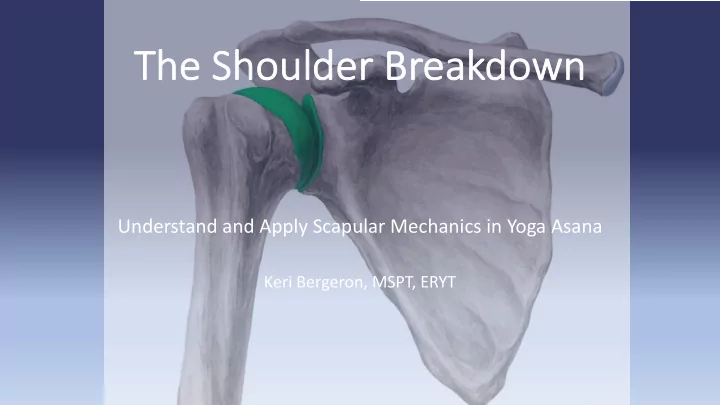

Th The Shoulder Br Breakdown Understand and Apply Scapular Mechanics in Yoga Asana Keri Bergeron, MSPT, ERYT
Shoulder Joint(s) • Four joints in one • Scapulothoracic: where scapula moves on ribcage • Glenohumeral joint: where humerus meets scapula (green here) • Acromioclavicular joint: where acromion meets collar bone • Sternoclavicular joint: where collar bone meets sternum • Glenohumeral joint is primary mover • Ball and socket joint • Primary movements: Flex/Ext, IR/ER, ABD/ADD • Designed for stability or mobility? Why?
Scapula Anterior View Left Scapula Posterior View Right Scapula
Shoulder Motions Defined • Flexion: raise arm forward and up overhead • The general rule is that flexion decreases the angle at a joint • Bending your elbow is the clearest example • Extension: reach or pull arms back behind the plane of your body • The general rule for extension is to increase the angle at a joint • Straightening the elbow from a bent position • Abduction: movement away from the midline of the body • Adduction: movement in towards the midline of the body • External rotation: rotation away from the center • Internal rotation: rotation towards the midline • Keep in mind: there are four joints that are working together to make these motions occur!
Scapular Motions Defined • Protraction: spread shoulder blades away from the spine. • Also called abduction • Retraction: draw shoulder blades together towards the spine • Also called retraction • Lateral rotation: rotation away from the midline • Medial rotation: rotation towards the midline • Elevation: draw shoulder blades up towards ears • Depression: draw shoulder blades down toward waist • Keep in mind that these motions most often occur in combination with each other
Glenoid Labrum • The labrum of the shoulder is a flexible cartilage ring that makes the socket, the glenoid, a little deeper and in turn, the shoulder slightly more stable. • Also the insertion for the long head of the biceps
• Function of Rotator Cuff: • Together they hold humerus in the glenoid and stabilize the humerus in glenoid through all aspects of ROM • Individual function: • Supraspinatus: initiates shoulder abduction • Infraspinatus and Teres Minor: external rotation • Subscapularis: internal rotation
Trapezius • O: superior nuchal line, ligamentum nuchae, C6-T12 spinous processes • A: scapular spine (lower and middle fibers), lateral end of clavicle/acromion (upper fibers) • Action: • Upper: elevate, laterally rotate scapula • Middle: retraction • Lower: depress, assists is lateral rotation with upper fibers
Rhomboids • Major and Minor • O: C6-T5 spinous processes • A: medial border of scapula • Action: strong retractors, medially rotate scapulae, can elevate as well
Levator Scapulae • O: tranverse processes of C1- C4 • A: superior angle of scapula • Action: elevates and assists with medial rotation of scapula
Latissumis Dorsi • O: T6-T12 spinous processes, lumbar fascia, iliac crest • A: intertubercular groove of humerus • Action: strong IR, adduction, and extension
Pectoralis Major • O: almost full length of sternum and medial half of clavicle • A: anterior humerus • Action: strong IR, horizontal adduction, can assist with flexion
Pectoralis Minor • O: ribs 3-5 • A: coracoid process of scapula • Action: protraction of scapula, assists with depression, accessory muscle of inspiration
Teres Major • O: inferior angle of scapula (posterior side) • A: anterior humerus • Action: strong IR of shoulder, extension
Deltoid • O: • Anterior: lateral end of clavicle (red) • Middle: acromion (green) • Posterior: spine of scapula (blue) • A: deltoid tuberosity of humerus • Action: passive stabilizer of shoulder joint, shoulder abduction • Anterior: flexion, IR, horizontal adduction • Middle: abduction • Posterior: extend, horizontal abduction, assist with ER
Serratus Anterior • O: medial border of scapulae on anterior surface • A: ribs 2-10 • Action: protracts scapula, keeps scapula engaged on back (no winging)
Scapulohumeral Rhythm • https://youtu.be/rpzBGlOEW4E • https://youtu.be/3VygGuBObVc • https://youtu.be/H_8xYrT8YcQ
Let’s talk Asana
Sources • Books: • Atlas of Human Anatomy, Frank Netter • The Key Muscles of Yoga, Ray Long • The Key Poses of Yoga, Ray Long • Photos: • www.physio-pedia.com • www.kenhub.com • www.motionplusosteo.com • www.Wikipedia.com • YouTube: • Manager3pleta Mps • Daily Bandha • Muscle and Motion
Contact Information • Website: www.keribergeron.com • IG: keribergeron • FB: Keri Bergeron
Recommend
More recommend